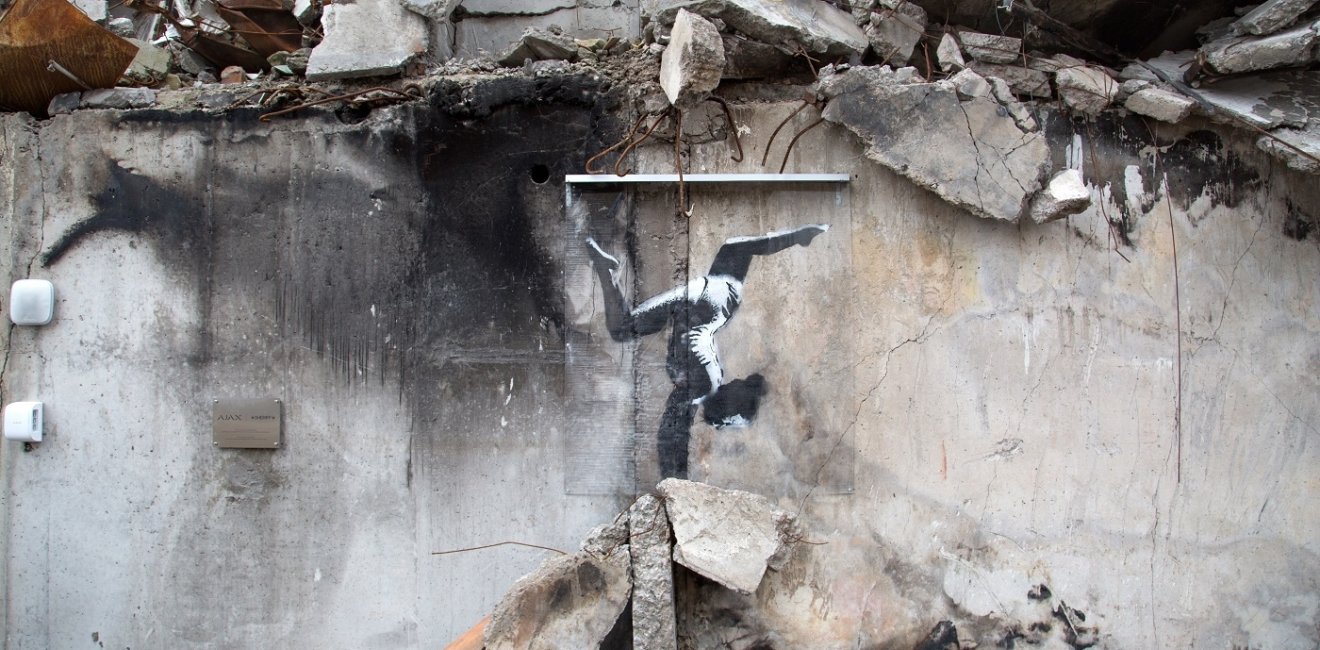
A blog of the Kennan Institute
Alexander Gavrilov never thought of himself as an artist. Prior to the full-scale Russian invasion in February 2022, he was an entrepreneur working on various IT and real estate projects in Ukraine. Russian aggression changed how he thought about himself, his country, and the world at large.
For Gavrilov, personal goals gave way to the obligation to focus on how to defeat Putin and his armed forces by any means necessary. Ukrainians began to act as a unified nation: some went to the front lines, while the others formed the rear. Those on the home front were called on to search out and procure what was necessary for the front lines and for those affected by the war.
About a year ago, Gavrilov’s military friends brought him a piece of a Russian helicopter shot down near Kharkiv. At first, he thought that the wreckage could be converted into small keepsakes that could be sold to raise money for the war effort. The more he contemplated how to convert an artifact of war into a means of raising funds for the war effort, the more he realized that he was thinking too small. The war’s artifacts of battle have become powerful symbols in Ukraine’s fight for freedom. He decided that they could be transformed into contemporary art that would serve as a lasting reminder of that has happened to his country.
Drawing on his IT and marketing experience, his project team established the Art of War website, offering art created from the detritus of war, with funds from sales being used to support Ukraine's fight. Through the project, the website explains, “young artists, sculptors, and craftsmen have come together with one goal: to present symbols of the war for freedom in a contemporary interpretation to the world. To exchange them for aid to those affected by the war, and to support our heroes fighting for the freedom of the nation.”
While not precisely converting swords into ploughshares, the artists selling their creations on the website are trying to transform the debris of battle into artistic dividends for peace. In some instances, vehicle parts, cartridges, tactical armor, clothing, and the like are offered untouched, as trophies of war. In others, artists use items to create works of art.
Gavrilov explains that the project’s main purpose is to create symbols of Ukraine’s struggle, the struggle of the entire nation, from the artifacts and testimonies of Russian invasion. All Ukrainians, he affirms, “are part of a civilization whole, united in the fight for our freedom against the dictator.”
“Letters,” for example, is a multimedia work offered on the site that focuses on the stories of children during war. Using notes from children found by Ukrainian soldiers upon taking an enemy encampment, the artists reveal the lost innocence of children who have been made to wear the letter “Z,” symbolizing the Russian offensive, who have been exposed to propagandistic literature intended to indoctrinate them into the Russian cause, and who have been given training materials for using lethal weapons. Another sculpture, “Rage,” reveals two hands ripping apart the wreckage of a Russian “Terminator” helicopter. In a third, “Oranta” (from the Latin orans, one who prays), the image of the Mother of God, with hands raised to the sky, has been created on a 100 mm casing from an anti-tank shell.
The clothing of war similarly is repurposed. In one instance, for example, an “unloading vest” used to carry ammunition left behind by a fleeing Russian soldier has been embellished with neon paint, with motifs of teeth and eyeballs, so that “all eyes will be on you in any situation,” according to its descriptive blurb. In another, a helmet once worn in battle has been painted pink and decorated with images of Hello Kitty.
The website encourages artists to transform the detritus of war into statements of peace. As Gavrilov wrote on his website, “our fields are sown with the destroyed equipment of the horde, which many of us look at as scrap metal. But in the hands of our masters, real scrap metal can be turned into artifacts of war and art from the war.” Through this process, they become “symbols of the struggle for freedom and independence.”
The Russian army has compelled Ukrainians to think about the meaning of their country for themselves, and for the world. Artists from all creative genres have drawn on this moment to reconsider and remake their art, be it painting, sculpture, theater, dance, or music. Others who never thought of themselves as part of the artistic community have embraced the arts as a means of expressing their patriotism and humanity. In both instances, Ukraine’s postwar artistic scene, when it begins, will be something fresh, new, inventive, and worthy of everyone’s attention.
The opinions expressed in this article are those solely of the author and do not reflect the views of the Kennan Institute.
Author

Former Wilson Center Vice President for Programs (2014-2017); Director of the Comparative Urban Studies Program/Urban Sustainability Laboratory (1992-2017); Director of the Kennan Institute for Advanced Russian Studies (1989-2012) and Director of the Program on Global Sustainability and Resilience (2012-2014)

Kennan Institute
After more than 50 years as a vital part of the Wilson Center legacy, the Kennan Institute has become an independent think tank. You can find the current website for the Kennan Institute at kennaninstitute.org. Please look for future announcements about partnership activities between the Wilson Center and the Kennan Institute at Wilson Center Press Room. The Kennan Institute is the premier US center for advanced research on Eurasia and the oldest and largest regional program at the Woodrow Wilson International Center for Scholars. The Kennan Institute is committed to improving American understanding of Russia, Ukraine, Central Asia, the South Caucasus, and the surrounding region through research and exchange. Read more

Explore More in Focus Ukraine
Browse Focus Ukraine
Talking to the Dead to Heal the Living

Ukrainian Issue in Polish Elections


